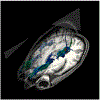Functional brain imaging in voiding dysfunction
- PMID: 31681452
- PMCID: PMC6824540
- DOI: 10.1007/s11884-019-00503-0
Functional brain imaging in voiding dysfunction
Abstract
Purpose of review: Voiding dysfunction (VD) is morbid, costly, and leads to urinary tract infections, stones, sepsis, and permanent renal failure. Evaluation and diagnosis of VD in non-obstructed patients can be challenging. Potential diagnostic and therapeutic options beyond the bladder, such as brain centers involved in voiding have been proposed as promising targets. This review focuses on current and future applications of functional neuroimaging in human in voiding and in patients with VD.
Recent findings: The current understanding of brain centers, and their roles in initiating, maintaining and/or modulating voiding, is rudimentary in humans and in patients with VD. With the advent and advancement in functional neuroimaging we are gaining more insight into specific brain regions involved in the voiding phase of micturition. In healthy individuals, right dorsomedial pontine tegmentum, periaqueductal grey, hypothalamus, and the inferior, medial and superior frontal gyrus have been identified as regions of interest in voiding.
Summary: Functional neuroimaging could suggest new diagnostic methods and provides crucial steps towards therapeutic options for the morbid and intractable VD condition, in patients with neurogenic (e.g. MS or Strokes) or non-neurogenic VD (e.g. underactive bladder or Fowler's syndrome).
Keywords: bladder dysfunction; fMRI; micturition; neuroimaging; voiding.
Conflict of interest statement
Conflict of Interest Dr. Boone has nothing to disclose.
Figures

References
-
- Panicker JN, Fowler CJ, Kessler TM. Lower urinary tract dysfunction in the neurological patient: clinical assessment and management. Lancet Neurol. 2015;14(7):720–32. - PubMed
-
- Wein AJ. Classification of Neurogenic Voiding Dysfunction. J Urology. 1981;125(5):605–9. - PubMed
-
- Lo TS, Shailaja N, Hsieh WC, Uy-Patrimonio MC, Yusoff FM, Ibrahim R. Predictors of voiding dysfunction following extensive vaginal pelvic reconstructive surgery. International urogynecology journal. 2017;28(4):575–82. - PubMed
-
- Griffiths D, Tadic SD. Bladder control, urgency, and urge incontinence: evidence from functional brain imaging. Neurourology and urodynamics. 2008;27(6):466–74. - PubMed
Grants and funding
LinkOut - more resources
Full Text Sources
Research Materials
